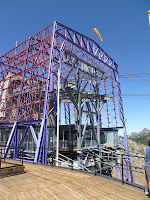If I were to ever get a tattoo, I’d get citius, altius, fortius tattooed across my forehead. The phrase means faster, higher, stronger and
is the motto of the Olympic Games.
Notably, it is not fast, high, strong – a simple string of adjectives
describing a current state. And the
Olympic motto is not fastest, highest, strongest – a set of superlatives fit
for a world record. No, the motto is citius, altius, fortius because the
Olympics are about constantly striving for improvement: channeling passion and precision to go faster;
climbing over obstacles and disappointments to climb higher; developing discipline
and determination to finish stronger.
On Saturday I thought about the Olympic motto – particularly
the higher part—when I was riding the cable tram up to Squaw
Valley, the site of the 1960 Winter Olympics. At 8200 feet, Squaw
Valley is more of a Big Chief Mountain Range than a valley. It took $80,000,000 to prepare the site for
the Olympic Games which included 685 athletes representing 30 nations.
 |
| Staring place for the tram. |
 |
| Tram station at the top of Squaw Valley (8300 ft). |
 |
| Higher: View from the cable tram. |
The state-of-the-art organization of the Squaw Valley
Olympics epitomized the Olympic ideal of constantly pushing the limits of mankind. The 1960 Games marked the first use of
artificial ice in the skating rinks. The
artificial ice was created in a refrigeration plant capable of cooling 4800
homes. Besides artificial ice, the 1960
Games introduced electronic scoring. IBM
built a scoring center (which looked more like a coffee hut) from which event
results were produced in French and English within two minutes after an
event. Going beyond electronic results,
CBS used instant replay for the first time after a skier was accused of missing
a gate in the slalom competition. Squaw Valley introduced the idea of an Olympic village
and is the only time all of the athletes ate together under a single roof. It is also the only Games for which Walt
Disney himself designed the Opening Ceremonies which involved 2,000 white doves
(released by event organizers) and a blizzard (released by God).
 |
| Higher - another view from the tram. |
As for the athletics, speed skating and biathlon were
introduced and bobsled was cancelled.
Airplane corner, an icy 90 degree turn in the women’s downhill ski
course, claimed 14 of the 27 participants.
The Olympic museum in the building with the cable tram had black and
white footage of crash after crash.
Despite knowing the danger, every participant attempted the course and
eventually a 19-year-old Bavarian named Heidi Beibl took first place over the
favored American.
 |
Steve and me.
|
In a sport with another type of pain, Kalevi Hamalainen from
Finland
won the gold in the 50 km cross-country skiing in 2 hours 59 minutes.
With the scarcity of oxygen in the Sierra Nevada, that’s an impressive feat of
endurance.
The fact that his
coach
forgot to tell him that he was entered in the race until right before it
started makes Hamalainen’s determination even more glorious. Knowing
the determination of his athlete, maybe the coach intentionally "forgot"
so that Hamalainen could focus on the 15 km and 30 km races that
preceded the 50 km.
At any rate, my journey up to Squaw Valley made citius, altius, fortius with its
powerful –er suffix seem more beautiful than ever.
 |
Citius, altius, fortius - Olympic Rings at the top of the tram.
|






No comments:
Post a Comment